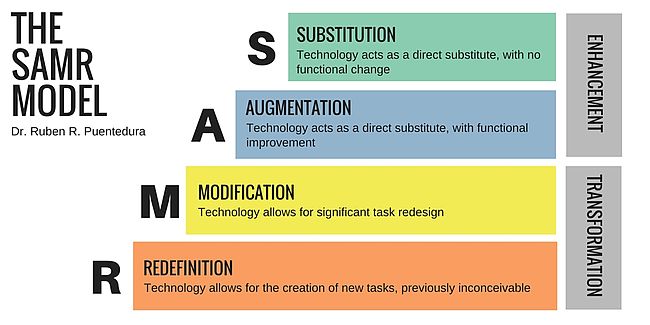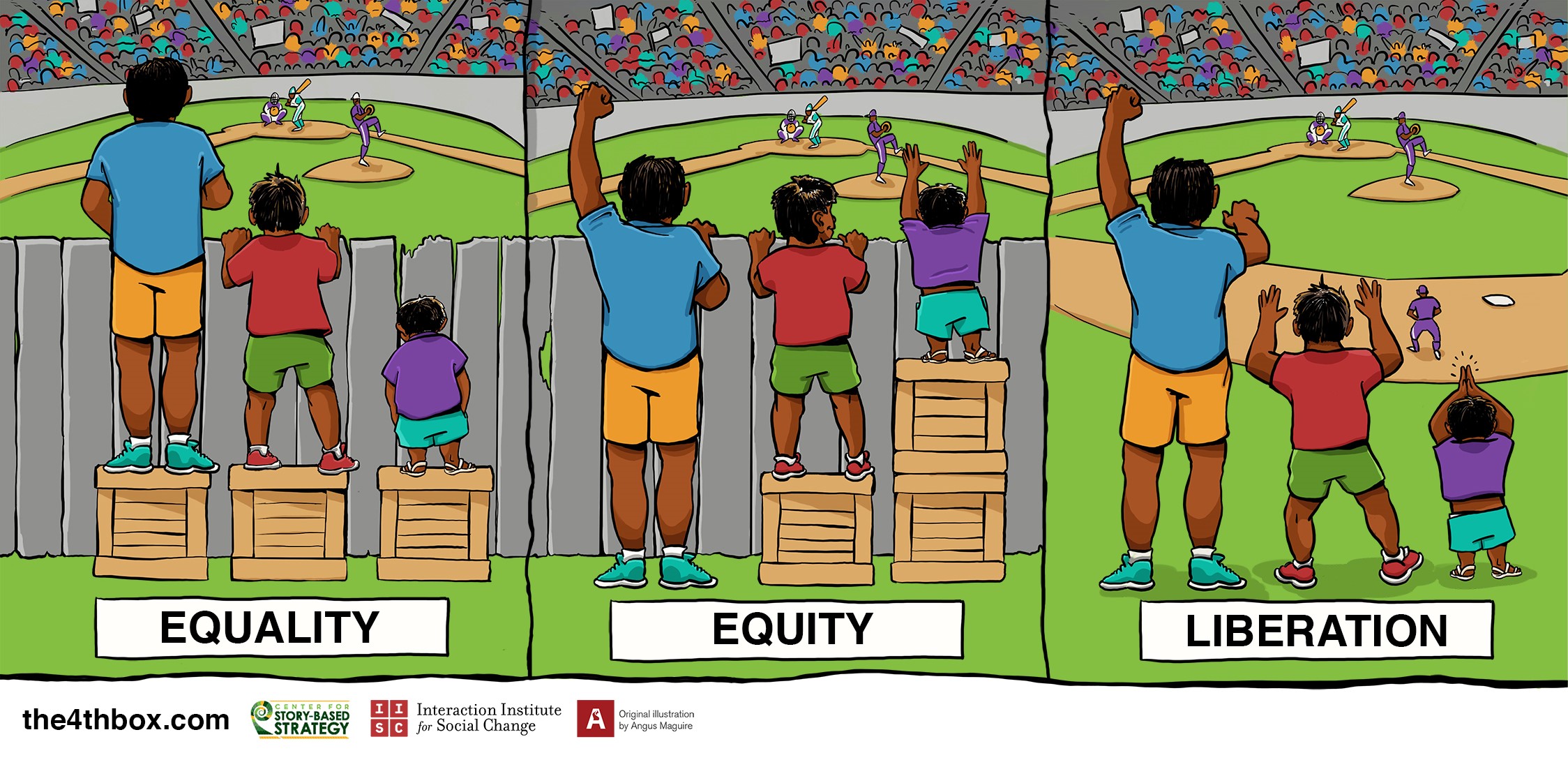Well no, and yes. It is an approach to causing learning that uses the empowering pedagogy that we call 'Learn Create Share'. This doesn't represent some sort of linear approach to learning. That is, these don't occur 'in order', but are in fact likely to occur in what at times can be an almost chaotic way. Some students may start by creating something. From that they may learn, and then share. Others, starting from Create may share and from that sharing to an authentic audience then learn something, and so on.
So where does the digital side of this all come in? Why do we keep talking about Chromebooks?
The technology is in fact only likely to have an impact if we use it to do stuff that we couldn't have done any other way. If we just do what we did before, then all we have is a $540 dollar pencil (to paraphrase the words of globally recognised educator Allan November).
Some technology advocates like to talk about the SAMR model for the use of technology in learning.
That looks like this:

Now I'm not a big fan of the model as some sort of definitive statement of the change that surrounds the use of technology. Here's one of the critiques (amongst many).
However, when all said and done, what it does establish is the need to move to that place where we are doing stuff with digital technology that we couldn't do without that technology, what in the SAMR model is termed 'Redefinition'.
So what is it that we might do that we might be doing that we couldn't otherwise be doing? The short answer is 'how long is a piece of string'? That is, 'crikey, where do I start'?
Perhaps the most basic is the ability to genuinely publish to an authentic audience. Take my earlier post about Mr Rees, and his class's work with sundials. That collaboration could only have occurred with digital technology. Similarly with other individuals: the student who had an author comment on a book review of her work, the student who had contact with a notable political figure. The list goes on.
We all have access to the rapidly growing suite of creative tools to devise or create new products, ideas, and learning. In this regard, Google has been 'stellar' in the development of new tools that form a part of what we call the G Suite.
Then there is the rather interesting impact of the technology on student writing. Research on the impact of digital tools on writing has been growing over the past decade and a half. This piece of research was some of the first.
"The Effect of Computers on Student Writing:-A Meta-Analysis of.Studies from 1992 to 2002"
Source: chrome-extension://oemmndcbldboiebfnladdacbdfmadadm/https://ejournals.bc.edu/index.php/jtla/article/download/1661/1503
What we know is that when asked to write electronically, students write more, and they wrote better. This reflects improved critical thinking. This explains why we see these results in our writing over the past three years:
Of special note here is the impact on Māori writing.. our Māori students are at the top, true liberation. Again I have to sue this wonderful image:

This is all stuff we could never do with just pencil and paper alone.
If we go back to our Learn Create Share pedagogy, much of this is seen though our students' blogging. Student blogs are by default publicly visible. Making learning visible, both through student blogs, and through the web sites that staff maintain that show the learning and the work they are completing, is essential to all of this work. This is important, as this means that students are publicising to an authentic audience, a real audience. It also means that they can 'rewind' that learning, (go over it again in their own time, at their own pace), and also that they can engage in something that Dr Eric Mazur of Harvard University calls flipped learning. This makes the learning very real. And if you really want to support your child's learning, read their blogs, make a comment on their work. This is an exceptionally powerful thing to do. If you are not sure how, give us a call. We have a great support team who will be available throughout term 2 .. just ask.
If we go back to our Learn Create Share pedagogy, much of this is seen though our students' blogging. Student blogs are by default publicly visible. Making learning visible, both through student blogs, and through the web sites that staff maintain that show the learning and the work they are completing, is essential to all of this work. This is important, as this means that students are publicising to an authentic audience, a real audience. It also means that they can 'rewind' that learning, (go over it again in their own time, at their own pace), and also that they can engage in something that Dr Eric Mazur of Harvard University calls flipped learning. This makes the learning very real. And if you really want to support your child's learning, read their blogs, make a comment on their work. This is an exceptionally powerful thing to do. If you are not sure how, give us a call. We have a great support team who will be available throughout term 2 .. just ask.
And so yet again we thank all Whānau who have chosen to make this really important investment in the learning of your tamariki. It is also a good time to once more urge all whānau who have yet to make this investment to do so. After your time, this is the next best investment you can make in your children's learning and success.
What is the point of our use of Chromebooks? It is to enable learners and staff to do things they couldn't otherwise do, not the least of which is your ability as whānau to see your child's work any time any where, and to make comment and give feedback.. any time, any where.
There is nothing more important nor more powerful.
I think having an authentic audience is a spur to critical thinking and helps students aim high.
ReplyDeleteJoanne
DeleteLet's not forget that your Drama is all about authentic audience too. Learn Create Share is not just about digital stuff. That said, the digital tools allow things we couldn't otherwise do. Thanks for the comment.
R
Kia ora Robin and thanks for sharing your thinking again!You have identified many of the critical elements in LCS. The Learn aspect runs through everything and underpins the pedagogy. This is truly transformational and as you demonstrate, allows students to do things they could not have previously done without the technology. LCS and the affordances of technology are definitely enabling creative excellence at HHS and leading the way for Uru Mānuka!
ReplyDeleteKia ora Robin,
ReplyDeleteOnce again the creation of the blog post is an excellent example of sharing to learn. The device can be a very expensive pencil, and Hornby High's efforts to focus the whole community on understanding Learn Create Share and the affordances that digital technologies enable ensure that the device is a $540 creative tool empowering Hornby High learners.
In term one as part of the Manaiakalani Outreach staff meetings throughout the country we focussed on RATE - Recognise effective teaching practice, Amplify effective teaching practice and Turbocharge the effective teaching through the use of the digital technologies.
We know what effective teaching looks like whether it is the use of SOLO in the school or embedding Ka Hikitia or looking at the Woolf Fisher Research Centre feedback. We need to ensure this effective practice is not "the baby being thrown out with the bathwater" when we introduce technology.
The amplification of effective teaching practice comes from the Manaiakalani pedagogy and kaupapa of Connected, Ubiquitous, Empowered and Visible — these four points highlighted in the research as the key to achieving acceleration in learning.
The turbocharging of effective practice using digital technologies is crucial to hook our learners and get them to engage with the curriculum. Technology enables increased quality of teaching-learning experiences that were either not possible before or were not equitable for all learners as the third image portrays — the ability to virtually visit the Pyramids of Giza or look at the Mona Lisa inside the Louvre are just a few of the examples I could draw on.
Thanks for sharing Hornby High's story,
Nga mihi,
Mark